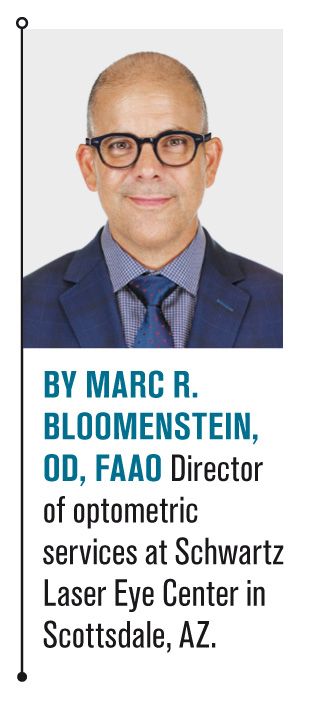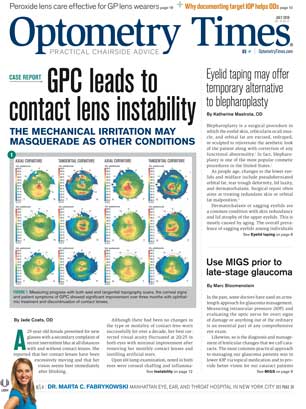Use MIGS prior to late-stage glaucoma
The introduction of micro-invasive glaucoma surgery (MIGS) has helped to successfully treat glaucoma patients. Take a look at why MIGS may be a useful treatment option prior to late-stage glaucoma.

In the past, some doctors have used an arms-length approach for glaucoma management. Measuring intraocular pressure (IOP) and evaluating the optic nerve for overt signs of damage or anything out of the ordinary is an essential part of any comprehensive eye exam.
Likewise, so is the diagnosis and management of lenticular changes that we call cataracts. The most common practical approach to managing our glaucoma patients was to lower IOP via topical medication and to provide better vision for our cataract patients via removal and replacement of the lens.
With the advent of micro-invasive glaucoma surgery (MIGS), we can now bring the management of both together in one process.
Qualifying patients for MIGS
The decision to refer a patient for MIGS is a change for some clinicians who withheld the notion of surgery for the late stage of the disease. However, when just using topical therapy, it may be more challenging to obtain an optimal IOP target.
Structural damage and progressive field loss were once the sole benchmarks to advise a patient for surgical intervention. Now, with advancements in nerve fiber evaluation and scanning technology, an earlier intervention is advised.
Identifying and overcoming obstacles
When considering surgery, the lack of compliance-estimated from 25 percent to 80 percent -also needs to be taken into consideration. As the Ocular Hypertension Treatment Study (OHTS) determined, 39 percent of eyes required two or more drops to achieve a 20 percent IOP reduction from baseline.1,2
Another hurdle for glaucoma management continues to be the economic burden on patients. Although new topical treatments are coming to the market, insurance barriers can become roadblocks to patients getting these medications covered under their insurances.
Drug cost is considered one of the leading road blocks to topical adherence.3 Combine the lack of patients’ enthusiasm with drops and the addition of multiple therapies, their treatment goals may not be realized. In the case of non-compliance, a MIGS procedure can bring a patient’s IOP down to a monotherapy level or possibly eliminate the need to for topical treatment.4
Previously from Dr. Bloomenstein: Preparing the periocular region for surgery
Form an action plan
Generally speaking, MIGS procedures are ab interno, microincisional, and conjunctiva-sparing. They share a common approach of minimal tissue trauma and minimal disruption of the normal anatomy and physiology.
MIGS may provide a solution for many challenges that face glaucoma patients. These challenges can include compliance, drop cost, and the ocular surface implications of glaucoma medications. The different devices lower IOP between 3.2 and 12.6 mm Hg; they are suited for mild to moderate glaucoma.
The reduction of IOP seems to be greater in patients with higher baseline IOP levels.5 The magnitude of the IOP-lowering effect seems to depend on the number of shunts or stents that are implanted.6 Besides the IOP-lowering effect, the surgeon may need to consider other parameters in deciding the best option for the patient.
The mode of action followed may be one criterion. The iStent (Glaukos Corporation) works by improving aqueous humor outflow at the structure of the physiological outflow into Schlemm’s canal, whereas CyPass (Alcon) and iStent Supra (Glaukos Corporation) are generating new and outflow pathways into the suprachoroidal space or the subconjunctival space with Xen (Allergan).
ODs must consider bleb evaluation with the Xen procedure.
Xen is a modern version of a traditional trabeculectomy. Xen reduces the side-effect profile that is accompanied with the traditional trabeculectomy. This is why an understanding of the pressure, bleb profile, and treatment options are necessary to manage these patients successfully.
Safety profile and communication
The safety profile of the different approaches should be considered-especially the risk for generating hypotony. Because of these considerations, surgeons may wish to use the Schlemm’s canal micro-stents in patients with mild to moderate glaucoma and the suprachoroidal and subconjunctival devices for the more severe cases of glaucoma.
It is important for the patient’s OD to engage in good communication with the cataract surgeon and glaucoma surgeon to determine which MIGS procedure will render the best outcome.
Managing a MIGS patient is very similar to managing a cataract patient. It is crucial to control the inflammation and the ocular surface for maintenance of good vision and healing. However, IOP management varies for each patient and procedure.
For example, the use of iStent has a very low risk of hypotony, whereas CyPass and Xen both have a higher risk of transient hypotony.7 Blood is involved in these latter procedures, and hyphemia and subconjunctivial hemorrhaging may be a post-operative consideration.
When managing glaucoma, it is important to take all forms of treatment under consideration.
References:
1. Olthoff CM, Schouten JS, Van De Borne BW, Webers CA. Noncompliance with ocular hypotensive treatment in patients with glaucoma or ocular hypertension: An evidence-based review. Ophthalmology. 2005 Jun;112(6):953-61.
2. Kass MA, Heuer DK, Higginbotham EJ, Johnson CA, Keltner JL, Miller JP, Parrish RK 2nd, Wilson MR, Gordon MO. The Ocular Hypertension Treatment Study: a randomized trial determines that topical ocular hypotensive medication delays or prevents the onset of primary open-angle glaucoma. Arch Ophthalmol. 2002 Jun;120(6):701-13; discussion 829-30.
3. Newman-Casey PA, Robin AL, Blachley T, Farris K, Heisler M, Resnicow K, Lee PP. Most common barriers to glaucoma medication adherence: A Cross-Sectional Survey. Ophthalmology. 2015 Jul;122(7):1308-16.
4. Neuhann TH. Trabecular micro-bypass stent implantation during small-incision cataract surgery for open-angle glaucoma or ocular hypertension: long-term results. J Cataract Refract Surg. 2015 Dec;41(12):2664-71.
5. Ahmed II, Katz LJ, Chang DF, et al. Prospective evaluation of microinvasive glaucoma surgery with trabecular microbypass stents and prostaglandin in open-angle glaucoma. J Cataract Refract Surg. 2014 Aug;40(8):1295-300.
6. Belovay GW, Nagi A, Chan BJ, Rateb M, Ahmed II. Using multiple trabecular micro-bypass stents in cataract patients to treat open-angle glaucoma. J Cataract Refract Surg. 2012 Nov;38(11):1911-7.
7. Chen DZ, Sng CCA. Safety and Efficacy of Microinvasive Glaucoma Surgery. J Ophthalmol. 2017:3182935.

Newsletter
Want more insights like this? Subscribe to Optometry Times and get clinical pearls and practice tips delivered straight to your inbox.